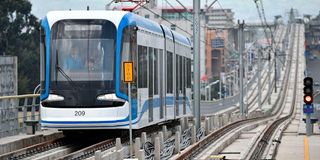How the Ethiopian light rail may define ties with China

A train operating on the light rail in Addis Ababa, Ethiopia. Ethiopia owes several international lenders worth about $27.4 billion and most of the debt falling due.
Ethiopia, like most sub-Saharan African countries, has had various struggles including repaying its debt to China and other lenders.
And last week, Prime Minister Abiy Ahmed told the Summit of the African Union that countries in the region will need certainty on repayment terms to cope.
“Now that the pandemic is over, nearly all of us want to put our economies back on a growth trajectory. But this will not happen without sufficient restructuring to make our external debt sustainable,” he said on February 18 during the 36th Ordinary Summit of the African Union. Among those in the audience were Zambian leaders, whose country has also struggled to repay. Others such as Kenyan, Angolan and Ghanaian leaders were also in the audience. These countries have also been bogged by debt.
“I, therefore, want to reaffirm our collective call for a fast and predictable global framework of debt restructuring that is conducive to accelerating sustainable, inclusive green growth in Africa,” Abiy said, indicating his country, like others, struggles after diverting funds to deal with emergencies.
Ethiopia owes several international lenders worth about $27.4 billion and most of the debt was falling due, including an estimated $200 million a year to Eurobonds due to mature in 2024.
In 2021, Dr Abiy joined a request to have repayments restructured under the G20 Common Framework, designed by the richest countries in the world to rearrange repayments for developing countries.
In January, visiting Chinese Foreign Minister Qin Gang indicated Beijing may cancel part of the $13.7 billion owed to China. China and Ethiopia had been tight pals, however. And much of the debt by Ethiopians was accumulated from recent infrastructure constructions such as the Addis-Djibouti railway, the Addis Ababa tram (Light Rail Train (AALRT) and the refurbishment of the Bole international airport in Addis Ababa.
It is the light rail, however, that may define how future relations will strain or strengthen. The light rail project became the first inner-city tram in sub-Saharan Africa in 2015, becoming a symbol of rising China-Africa ties. But it is now an overloaded piece of infrastructure that needs constant repairs, by the Chinese.
An investigation published in the Diplomat magazine this month says the tram is facing insufficient spare parts and a lack of maintenance experts, in spite of a planned tech transfer to train local experts.
“It is also much cheaper than any other means of transport. However, the fact that it is not working properly leaves Addis not only with irritated passengers but also with a company that is losing money,” argued Istvan Tarrosy and Zoltan Voros, professors of political science, who investigated the project for the magazine
Tech transfer is something the Chinese agreed on in the recent Forum on China-Africa Cooperation, placing it side by side with innovation as crucial areas of future China-Africa ties. And while the Covid-19 pandemic may be cited for a stall in the transfer in Ethiopia, delays in repairs mean the cost of running the light rail is higher today.
Inadequate imports of spare parts and shortages of technicians forced the government to extend the contracts of two Chinese experts who were handling the services in transition, according to Addis Fortune. This is besides the fact that the rail service also struggled to make money when it was launched.
A study in 2019, just before Covid-19, by Addis Ababa University showed that the damage was largely caused by overloading, even though it was carrying fewer passengers per day on average. While it was expected to carry 60,000 per hour, it was ferrying between 105000 to 110,000 a day
The on-train vehicle carried 254 passengers when seated but could accommodate up to 317 passengers standing. The study indicated each was carrying up to 60 passengers more than the permitted maximum number.
“The Addis Ababa Light Rail Transit (AA-LRT) trains are being subjected to a high volume of passenger overcrowding, especially during peak hours of the day. Due to this, the traction motors are meeting a mechanical load that exceeds the designed overload capacity of the train,” said the report of the Study of Train Overloading and Its Impact on the Traction Motors: Case of AA-LRT N-S line.
During the Covid-19 season, fewer people travelled on the tram. But officials found there had been vandalism of the light rail furniture, adding to the costs. The light rail was worth $475 million and was estimated to cost 13 percent of the initial cost to run it. The recent damages however have seen local officials say they may need $60 million to fix it.





